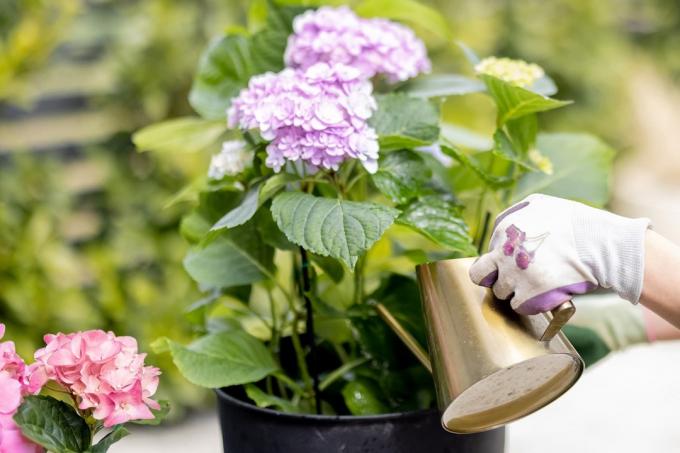
Hydrangeas are one of the most popular ornamental plants in this country. While they usually survive the winter without any problems when planted out, caution is advised in the tub culture. We'll tell you how much frost hydrangeas can tolerate in pots.
In a nutshell
- Hydrangeas planted out are hardy
- Potted hydrangeas need winter protection
- do not overwinter small plants outdoors
- protect large potted hydrangeas from the first frost
- Don't forget to water even in winter
Table of Contents
- Hardiness of Hydrangeas
- Hardiness in the bucket
- Small Hydrangeas
- Large hydrangeas
- frequently asked Questions
Hardiness of Hydrangeas
The plant genus Hydrangea (Hydrangea) belongs to the Hydrangea family (Hydrangeaceae) and includes different species. The ornamental plants are easy to care for and tolerate temperatures of winter hardiness zones (WHZ) 5 to 7 when planted in the bed, depending on the species. The table below provides an overview of the hardiness of the most popular hydrangea species.

| hardiness zone | temperatures | hydrangeas |
|---|---|---|
| WHZ 7 | - 17.8 to - 12.3 degrees Celsius | Oak-Leaf Hydrangea (Hydrangea quercifolia) |
| WHZ 6 | – 23.4 to – 17.8 degrees Celsius | Ball Hydrangea (Hydrangea arborescens) peasant hydrangea (Hydrangea macrophylla) Velvet hydrangea (Hyrangea aspera ssp. sargentiana) Hydrangea (Hydrangea serrata) |
| WHZ 5 | - 28.8 to - 23.4 degrees Celsius | climbing hydrangea (Hydrangea petiolaris) Panicle Hydrangea (Hydrangea paniculata) |
Hardiness in the bucket
When kept in a bucket, however, the information on winter hardiness must be considered differently. Frost and cold penetrate through the walls of the planter, which is why the substrate freezes faster. This causes the roots to die and the plant to die. Therefore, hydrangeas do not survive the winter on the balcony and terrace without protection.

A notice: Hydrangeas in pots need to be watered regularly. Also in the winter. If they lack the water they need for life, they die of thirst.
Small Hydrangeas
How much frost the hydrangeas actually tolerate depends on their type and the size of the pot. Plants that are kept in a pot with a diameter of less than 35 centimeters should not overwinter outdoors. A frost-free winter quarters with a constant temperature between three and five degrees Celsius is recommended here. Suitable quarters are, for example, the garage, a cold house or a shed. It is important that the move takes place before the first frost.
Large hydrangeas

If the pot diameter is more than 35 centimetres, you should overwinter your hydrangeas outdoors, as they need the cold to hibernate. When you attach the winter protection depends on the climate in your region:
- Pack: before the first frost
- Unpack: when no more frost is to be expected
A notice: If you were surprised by the night frost, your potted hydrangeas have a good chance of surviving if you pack them up immediately. As a rule, the ornamental plants survive one to two nights with temperatures between -5 and -10 degrees Celsius.
frequently asked Questions
To ensure that your hydrangeas survive frost on the balcony and terrace, wrap the pot with plant fleece and/or a coconut mat. Against the cold from below, place the plants on a thick wooden board or a piece of polystyrene. Cover the substrate with brushwood.
Potted hydrangeas that overwinter outdoors don't need a lot of water. However, the substrate should never dry out completely or become bone dry. Therefore, you should water the ornamental plants as needed on a frost-free day.
The best place for hydrangeas to overwinter on the balcony and terrace is a wind and rain-protected spot on the wall of the house. In addition, the ornamental plants should be in the sun.



